As the 2023 safari rally which is being broadcast live continues, we take a look at one of the most iconic photos of this prestigious event. At the 1993 Safari Rally in Kenya, what is thought to be Ian Duncan’s Toyota Celica GT-Four ST185 is actually the Toyota Celica GT-Four belonging to the one and only Juha Kankkunen’s car number 1 but driven by Ian Duncan for a photoshoot that soars beyond a crest. Overlooking the automobile from Tanzania across the border is the snow-capped Mount Kilimanjaro, Africa’s highest peak at 5,895 meters.
Watch the 2023 Safari Rally Live
The Kenya National Broadcaster KBC channel 1 is showing the safari rally live.
Two Maasai villagers are observing as an azure sky soars over the snow and dry soil below.
Staged photos, real safari rally
The iconic photograph of a flying Toyota Supra (and later the Celica) next to two Maasai tribesmen with Mount Kilimanjaro and crystal-clear blue skies in the distance is one of the greatest illustrations of this safari rally in Kenya.
It is without a doubt a beautiful photograph, taken by the renowned McKlein Agency, and it is included in their “Best of” archives.
It is NOT, however, a genuine “live” image captured during the Safari Rally. The 1987 photo was shot during the two-week pre-rally “recce,” and that specific crest was never a part of any stage. It features the #4 Supra driven by Lars-Erik Torph and Benny Melander.
Additionally, you can see that Torph and Melander were not sporting helmets, which was not permitted on a live stage. The fact that the well-staged shot gained such notoriety became the punchline of jokes, as this humor comic strip demonstrates.
Far worse is the 1993 version, which seems to show the #1 crew of Kankkunen and Piironen, who won the race, but is really even worse since it purports to show two random crew members in a photo session that was planned after the race.
You can see that those shots of the two Toyotas weren’t even the first to use that exact layout by scrolling through the album, which also includes pictures of Nissan and Lancia.
A different image of Kankkunen’s #1 Celica from 1993, this time is driven by Ian Duncan, sliding around a turn with Kilimanjaro in the background, is among other incredibly famous yet staged Safari Rally images.
The gorgeous photograph of Carlos Sainz’s 1992 Celica driving through a huge cloud of dust, as well as the lesser-known photograph of the identical action in 1987 with the #4 Supra, the 1994 photograph of the two Toyotas with a helicopter in the background (actually taken during testing), and numerous photographs of various large animals with passing cars, many of which were taken during photo shoots in the Amboseli National Park (n)
You’ve undoubtedly already noted how similar the two pictures are. What a remarkable coincidence, don’t you think?
- yes, all photos are taken in Africa, in Kenya
- yes, all photos are dedicated to the Safari Rally
- yes, all photos belong to the “pen” of photographers of the famous McKlein agency
- yes, all photos are included in the “gold fund” and the “best of the best” agency McKlein
But this is not the most important thing!
We’ve listed the obvious, but what else? What is the main (and, to put it mildly, little known) fact that unites all these shots?
I am sure that you will not be able to name the correct answer. But before voicing it, we want to apologize to you for now destroying your dreams and ideas about the Safari Rally …
The fact is that all these shots that set an amazing romantic mood are fakes! All of them were made not during the race, but during specially organized photo shoots. At the same time, at the wheel and in the place of the navigator, sometimes there were completely different riders who were supposed to be there. And sometimes they weren’t even racers at all.
When I suspected something was wrong, I turned to two legendary navigators and received the same answer from them: “Yes, it’s true. The most beautiful photos from “Safari” were taken during the tests, practice (familiarization) and after the race. Because we used the same race cars, and it was possible to capture everything beautifully in a calm environment. ”
How do you like this news? We are in shock too! But the interesting facts did not end there. Let’s go through each frame individually…
1. Toyota and Maasai warriors against the backdrop of Kilimanjaro
Perhaps the most legendary footage allegedly taken at the Safari Rally. A Toyota flies in the center of the frame, Masai warriors stand to the right, and Mount Kilimanjaro rises in the background. Blue sky, no clouds. Beauty and more:
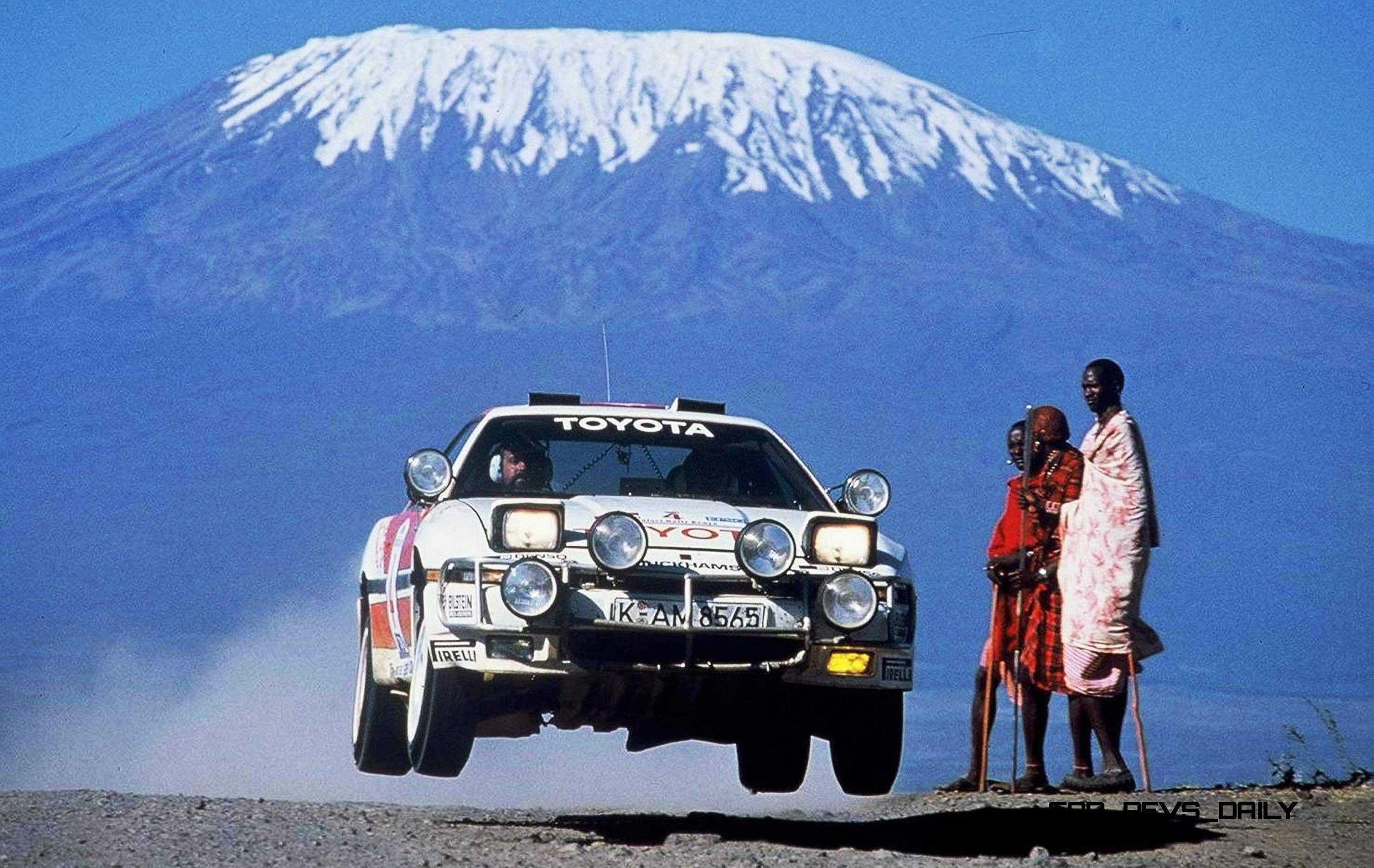
One of these photos even appeared on the cover of the 1997 book Rally (McKlein, 392 pages, hardcover):
But you know what confused me? How did this investigation start? Painfully, the plot coincided – both in 1987 and in 1993, the car of the same team was captured as if it were a carbon copy. Even the locals stand in the same place. And it’s been six years. Well, it must have coincided, right?
No, it didn’t match. Or are these shots also a “coincidence”?
Or maybe this Toyota Celica also accidentally caught the eye of a photographer flying against the backdrop of Kilimanjaro?
Of course not. All of these are special photo shoots taken before or after the rally. And there would be nothing terrible in this if it were not for a number of facts that allow us to call these shots a full-fledged fake.
1. This ski jump has never been included in the route of the Safari Rally. It is located more than twenty kilometers away from the nearest special stage.
2. In the picture of 1987, you can clearly see the crew of Lars-Erik Thorp and Benny Melander sitting without helmets, they have only headphones on their heads. The shot was taken before the race during a two-week familiarization with the race track. By the way, cartoonists in those years did not hesitate to tease the Toyota team for its photo shoots – such a cartoon can be found on the net:
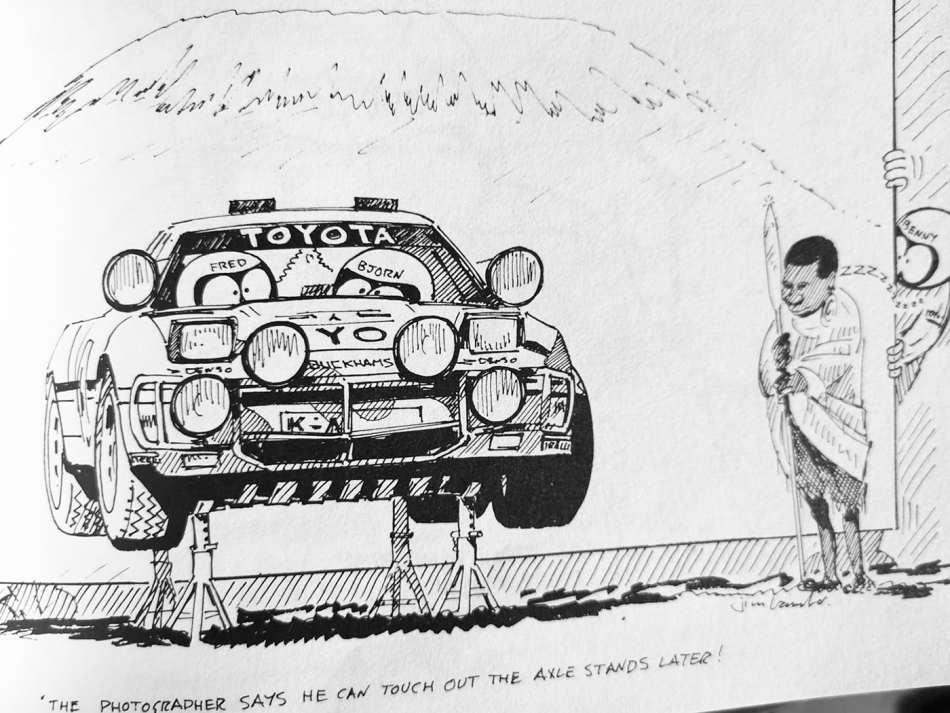
3. The 1993 shot is even funnier – it was taken after the Safari finish. This frame is signed approximately the same in various publications: “The winner of the 1993 Safari Rally, Juha Kankkunen, is on his way to first place.”
Only it’s not Kankkunen. The car is his, but he himself is not in the car. After the end of the 1993 race, the team washed the Toyota Celica Turbo 4WD (ST185) from tons of dirt, put two mechanics (!!!) in the car, put on helmets and went to jump from the ski jump.
And the representatives of the Maasai tribe … were paid for their participation in the photo shoot!
If anything, this is what the Toyota Celica actually looked like during the race. Impeccable cleanliness, right? [joke]
It is curious that these photos autographed by Kankkunen come across on the Internet. Although he knows for sure that it is a fake. The cunning Juha does not betray his former employers.
4. Directly during the Safari Rally, Mount Kilimanjaro is always covered by clouds. Therefore, real shots of rally cars during the passage of the special stage closest to the mountain look like this:
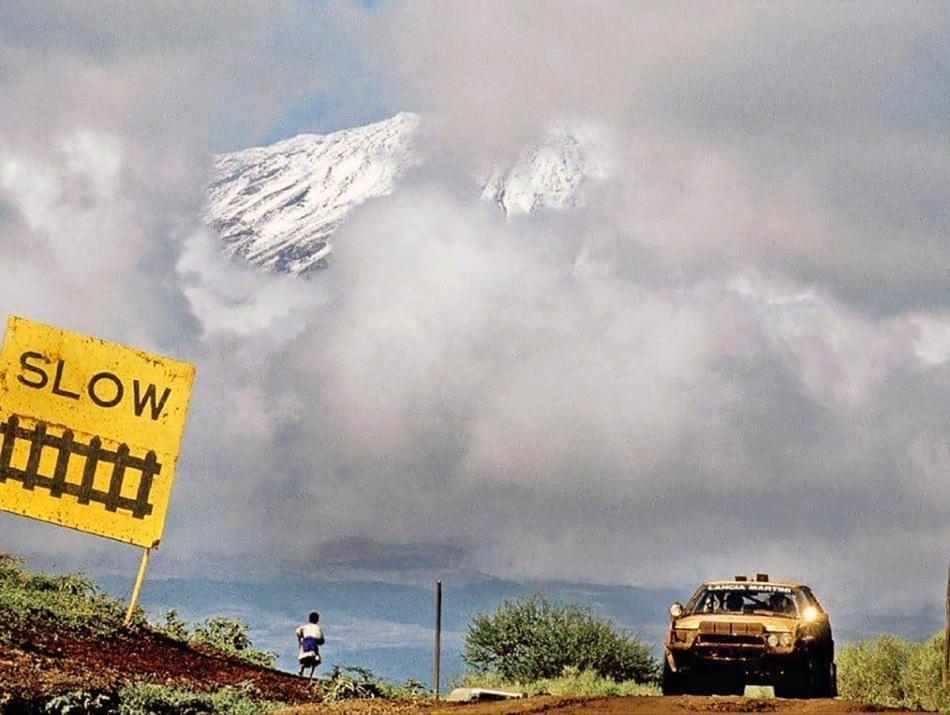
Note:
- the track is a mud mush, not pure gravel
- the car is covered in mud, and not licked to perfect condition
- mountain in the clouds, its top is almost invisible
- instead of Masai warriors there is some local boy
- there are some pillars in the frame, a bald mound and the roof of an outside car in the background
Not so beautiful and impressive anymore? But this shot was taken during the race!
And yet – during the photo shoot in 1993, video was also filmed:
Everything would be fine, but at the last second it is clear that in addition to the Maasai warriors, ordinary Kenyans, dressed in normal clothes, were standing on the side of the road. But during the shooting, the photographer competently “removed” them from the frame, aiming the lens only at the Maasai.
And the last. In 1999, Toyota again decided to try using the Maasai warrior scene in its photo shoot – the crew of Didier Auriol and Denis Giraudet worked with photographers:
2. Kankkunen in a beautiful skid with Kilimanjaro in the background
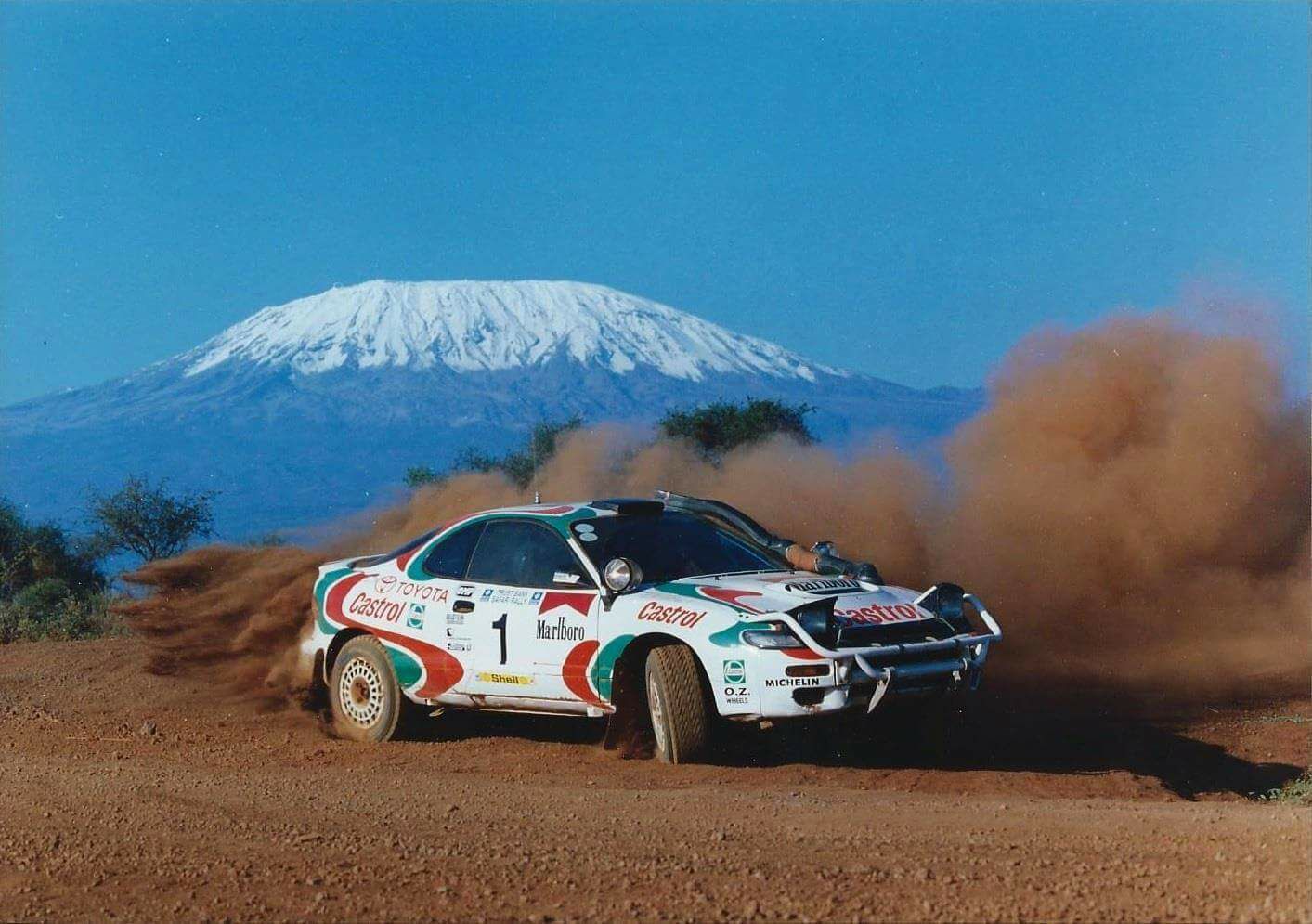
Another legendary photo. And again, the future winner of the 1993 Safari Rally, Juha Kankkunen, in a beautiful skid against Mount Kilimanjaro, drives his Toyota Celica to first place …
But are you already seeing the first signs of a fake? Yes, Kilimanjaro is visible in all its glory, which means that the photo was not taken during the race. However, this is not all the facts…
Kenyan Ian Duncan is driving the car. He participated in the 1993 Safari Rally in exactly the same Toyota and even finished third overall. Only now the tail number of his car was “3”, and the number “1” was on Kankkunen’s car.
In the right seat of the car is one of the mechanics of the Toyota Team Europe. They just offered him a ride.
In the turn where the photo session took place, the crew, consisting of Duncan and an unknown mechanic, drove many times to make the photos as spectacular as possible. In fact, several frames were filmed there – the passage of the turn looked something like this:
3. Toyota Hippo
Toyota Celica drives up to a puddle, drives into it and suddenly plunges almost up to the roof into a mud bath. Then he calmly leaves and moves on:
These shots are a personal pain for me. After all, these are my favorite photos of the Safari Rally. And it was not only photography, but also frames from the video:

However, this is also fake. With all due respect to the A-group Toyota Celica, it was not strong enough to withstand such a test. After driving through this mud bath, the car had to replace the engine and gearbox – they were out of order.
Well, as they say, to the heap. This is also a special photo shoot – also a fake:
4. Two Toyotas and a helicopter
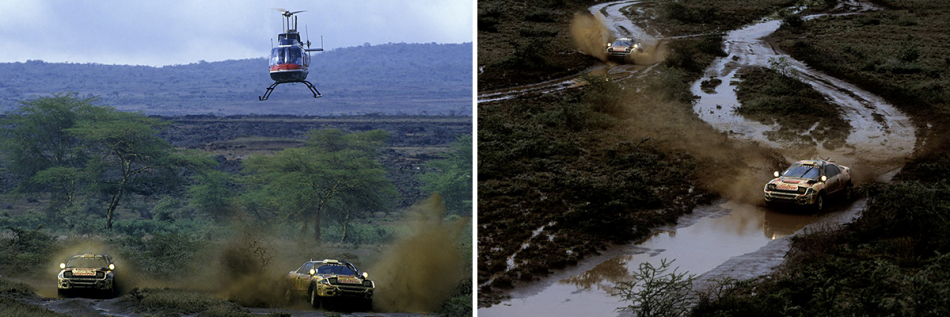
Two more photos that even on the website of the McKlein photo agency go under the tag “Best of McKlein”. African round of the 1994 World Rally Championship. The pictures show two Toyota Celica crews of the Toyota Team Europe factory team:
5. Rally cars and animals
During the existence of the Safari Rally, a million billion photographs have been taken with such a plot. Here are just a few of them:
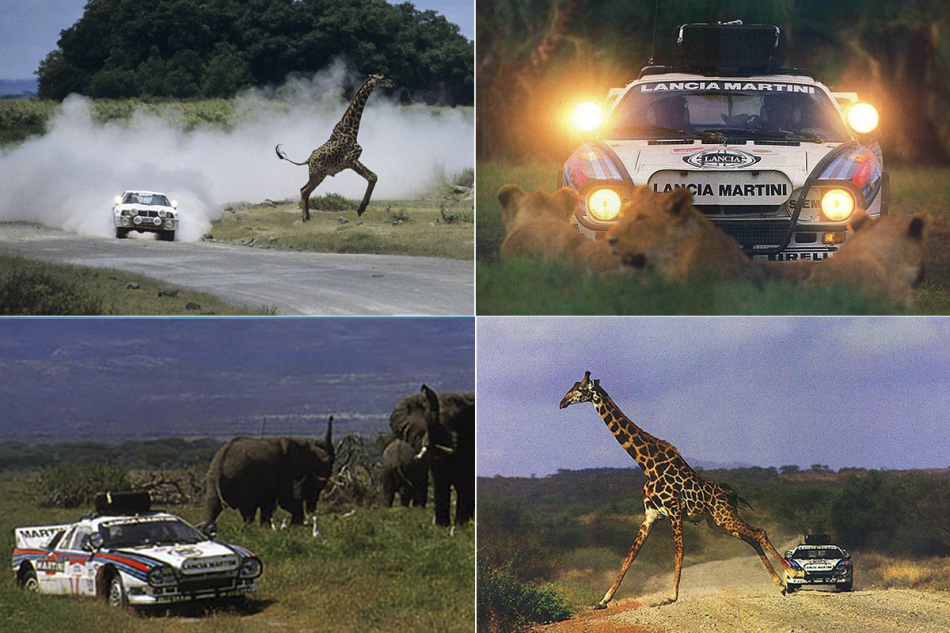
Have you already guessed? Every single one is fake, made not during the rally and not on the race track. Photo shoots with animals have always been organized in the Amboseli National Park. Of course, no one thought to make a rally track there – the crews specially went there for shooting.
A moment of geography. The park was founded in 1974 and is located in the Loitokitok region of the Rift Valley province in southeastern Kenya. The park is 392 square kilometers and is located at the center of a three thousand square kilometers ecosystem that crosses the border of Kenya and Tanzania. The park is located 240 kilometers southeast of the capital of Kenya – the city of Nairobi – and is the most visited national park in Kenya. This is partly due to the beautiful scenery of animals against the background of Mount Kilimanjaro, as well as the opportunity to get up close to elephants grazing among other animals.
Racers and photographers skillfully used this opportunity, creating photo masterpieces against the backdrop of wild animals. And the audience had no idea that all this has nothing to do directly with the race.
By the way, in the photographs, the crews of the Lancia Martini factory team “burned out” most of all – their test cars (they also served as familiarization vehicles) outwardly looked like combat ones, but instead of the starting number, there was a Practice sticker on the side doors. Sometimes this inscription was pasted over, but from this, of course, the tail number did not appear – just as the helmets on the heads of the pilot and navigator did not appear either. They are wearing headphones – it’s not in racing mode:
So if you saw a photo that was supposedly taken during the Safari Rally, but there are animals in the frame, you should know: this is not a race at all!
6. Fesh fesh – Dust, dust and more dust
At one time, the McKlein agency released another book – it was entirely devoted to the Safari Rally. On its cover there were at least two fake photos “from the race”. Find?
Well, we have already discussed the first fake – a flying Toyota Supra and Maasai warriors.
But the second fake is actually the main photo: a 1992 Toyota Celica skidding in the powdery dust otherwise known as “fesh fesh”. The photo session was held after the end of the rally:
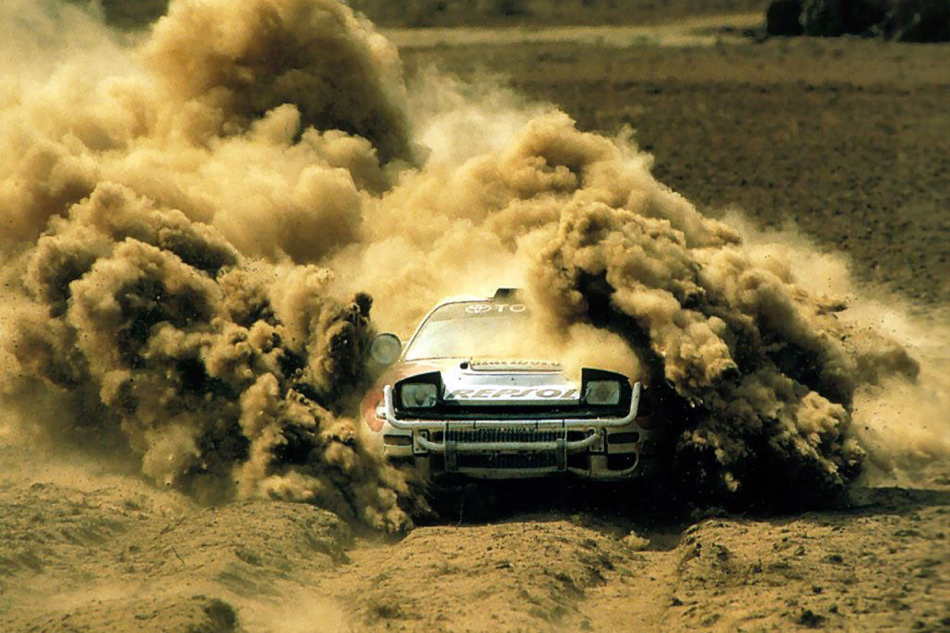
In order to take such a shot, the photographers of the agency asked the pilot to skid desperately in a sand trap, and sometimes resorted to the help of a helicopter – it took off above the stuck car and added real clouds of dust.
“McLane” used this technique more than once – they did such a survey for both Toyota Team Europe and their competitors from Lancia Martini:
Below is an insightful interview that goes deeply into this revelation
The truth
Reinhard Klein, a talented photographer with the McKlein agency, created the picture. We get a behind-the-scenes look at a masterpiece from a man who attended every Safari Rally from 1978 until it was discontinued by the WRC in 2002.
Question: Reinhard, could you please describe how you got this amazing picture?
Answer: This photograph was taken during testing rather than the actual rally. For Toyota, who wanted pre-event coverage to ratchet up the enthusiasm for the Safari, Ian conducted the testing in Africa. Why not combine the video and photo team to capture them as they drive up and down the roads? It invited the rally team to assist since it was already down there with practice cars and test cars.
Question: It was a promotional photograph, then.
Answer: Exactly. The film crew was under the direction of Marion Bell-Andersson, the wife of Toyota Team Europe manager Ove. Toyota did this at numerous events in order to have content after the rally was ended.
They prepared photography in advance because it took so long to be quick for daily publications in those days. They simply pressed the advertisement’s button when they were successful.
Question: Do you have any prior knowledge of this area?
Answer: I was pretty familiar with Kenya, and I was aware that Toyota desired the ideal Kilimanjaro photo. The Pipeline Road was the previous name of the street. Coming from Kilimanjaro up to the main Mombasa road, it was perfectly straight. Today’s Tarmac is fantastic.
Question: It’s a spectacular location, right?
Answer: The continent itself. You can engage in both safari and Kilimanjaro climbing activities in Africa. Only in the early morning, from roughly 06.30 to 08.30, is the mountain typically visible.
Normally, it is clear at that time, but in April around Easter, the rainy season is slowly beginning and there is a lot of clouds gathering, so it is starting to cloud over early in the morning. You must arrive at the venue early.
Question: How did you prepare?
Answer: We arrived the previous evening and spent the night close to the mountain and the Amboseli National Park. We looked around the area, and there was that one brow I recognized. It couldn’t really be taken flat out in the rally or in open traffic since the drivers couldn’t see what was coming from the opposite side. We essentially blocked off the road in the morning.
In Africa, you can use a hand signal to signal caution rather than closing the road to ensure that no one is approaching. To fly properly, Ian gave it his all. They wouldn’t even take off during the demonstration. Maybe only 20 kph separated them, but that was enough to affect the picture.
Question: How did the Maasai get engaged, if at all?
Answer: Getting the Maasai to stand along the roadside was the ultimate trick. They wanted some compensation, of course, but the issue was that they were terrified when the car was approaching at full speed. They are accustomed to cars moving at 50 kph. They fled when the automobile approached since this one was traveling at 170 kph!
We claimed that we hadn’t finished the photo since you had fled, but they insisted that you just pay for one picture. Then we had to bargain once more. A few shots were required, and each time we had to pay. They had to get acclimated to the speed, find the proper spot to stand, and refrain from fleeing. After a few failed efforts, we eventually managed to put everything up. The Maasai were accustomed to the speed, they remained in place, they were confident in their safety, the automobile leapt well, and Kilimanjaro was bathed in beautiful sunshine.
Question: Astonishing results followed.
Answer: It was amazing footage that was and still is utilized all over the world. It generated a lot of exposure for both the rally and the Safari. One of my favorite pictures is that one. In contrast to the usual situation where you simply walk to a spot and something happens, this was more like a studio-style plot than merely observed action.
Related: WRC Safari Rally: Rovanpera wins as Toyota scores 1-2-3-4
With victory at the demanding Safari Rally Kenya, Kalle Rovanpera won the 2022 safari rally event hence strengthening his case for the World Rally Championship championship, with Toyota controlling the top four spots.
| POS | CAR NO | DRIVER | CO-DRIVER | TEAM / CAR | ELIGIBILITY | TOTAL TIME | ||||
|---|---|---|---|---|---|---|---|---|---|---|
| 1 | #69 | K. ROVANPERÄ | J. HALTTUNEN | M | 3:40:24.9 | |||||
| 2 | #33 | E. EVANS | S. MARTIN | M | 3:41:17.7 | |||||
| 3 | #18 | T. KATSUTA | A. JOHNSTON | MT | 3:42:07.6 | |||||
| 4 | #1 | S. OGIER | B. VEILLAS | M | 3:42:35.2 | |||||
| 5 | #11 | T. NEUVILLE | M. WYDAEGHE | M | 3:51:05.8 | |||||
| 6 | #42 | C. BREEN | P. NAGLE | M | 4:03:52.8 | |||||
| 7 | #9 | J. SERDERIDIS | F. MICLOTTE | None | 4:10:41.4 | |||||
| 8 | #19 | S. LOEB | I. GALMICHE | M | 4:12:37.5 | |||||
| 9 | #20 | K. KAJETANOWICZ | M. SZCZEPANIAK | WRC2DC | 4:16:02.5 | |||||
| 10 | #2 | O. SOLBERG | E. EDMONDSON | M | 4:18:01.5 | |||||
| 11 | #22 | S. JOHNSTON | A. KIHURANI | WRC2DC | 4:35:10.7 | |||||
| 12 | #27 | A. SINGH RAI | G. SINGH PANESAR | WRC2DJC | 4:45:16.4 | |||||
| 13 | #16 | A. FOURMAUX | A. CORIA | M | 4:59:52.6 | |||||
| 14 | #44 | G. GREENSMITH | J. ANDERSSON | None | 4:59:57.0 | |||||
| 15 | #28 | A. VIRANI | A. BHATTI | WRC2DC | 5:18:53.6 | |||||
| 16 | #34 | M. WAHOME | M. WAIGWA | WRC3 | 5:20:21.6 | |||||
| 17 | #38 | N. SACHANIA | D. PATEL | None | 5:27:44.6 | |||||
| 18 | #30 | J. WAHOME | V. OKUNDI | WRC3 | 5:45:49.0 | |||||
| 19 | #41 | M. RATHOD | J. MACTAVISH | None | 5:54:30.5 | |||||
| 20 | #32 | M. KIMATHI | M. KIONI | WRC3 | 5:55:59.3 |
Ian Duncan’s Flying Sausage – Toyota Celica
This is the same car that Ian Duncan drove in the previous safari rally events. In a Toyota Celica called “The Flying Sausage” and sponsored by Farmer’s Choice, Ian Duncan won the Safari Rally in 1994. Farmer’s Choice has sponsored Rob Collinge, and the company has named his Datsun 260Z “The Flying Sausage” in keeping with tradition. The “Flying Sausage” appears poised to win once more as rally history is about to repeat itself.
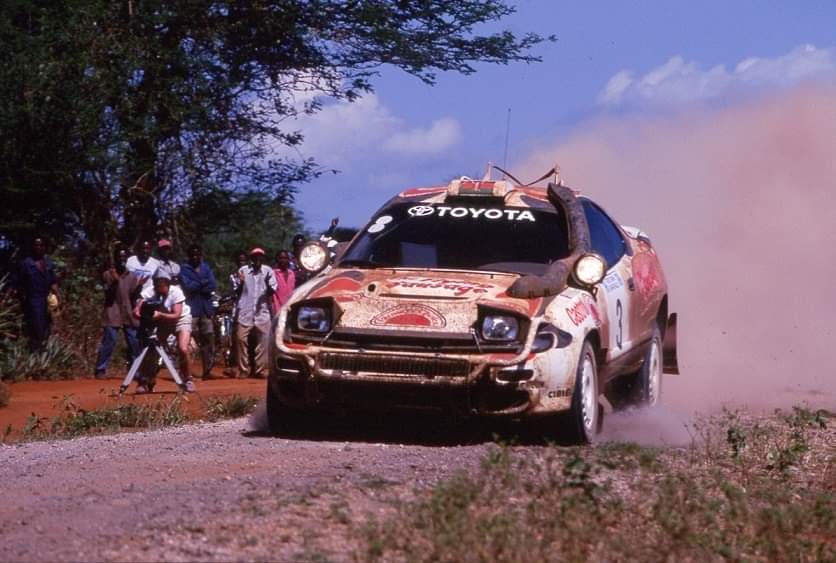
![]()

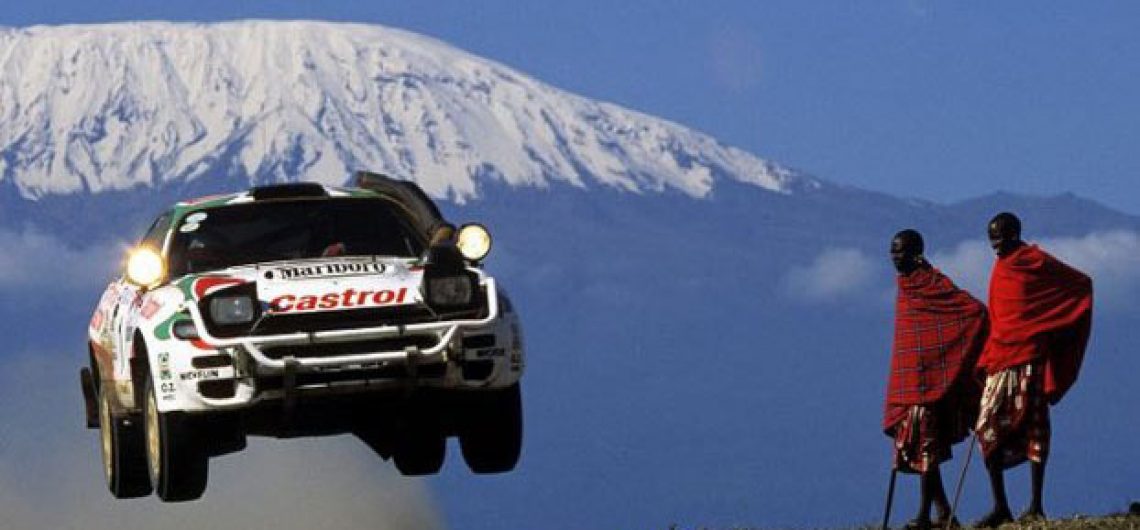
Comments